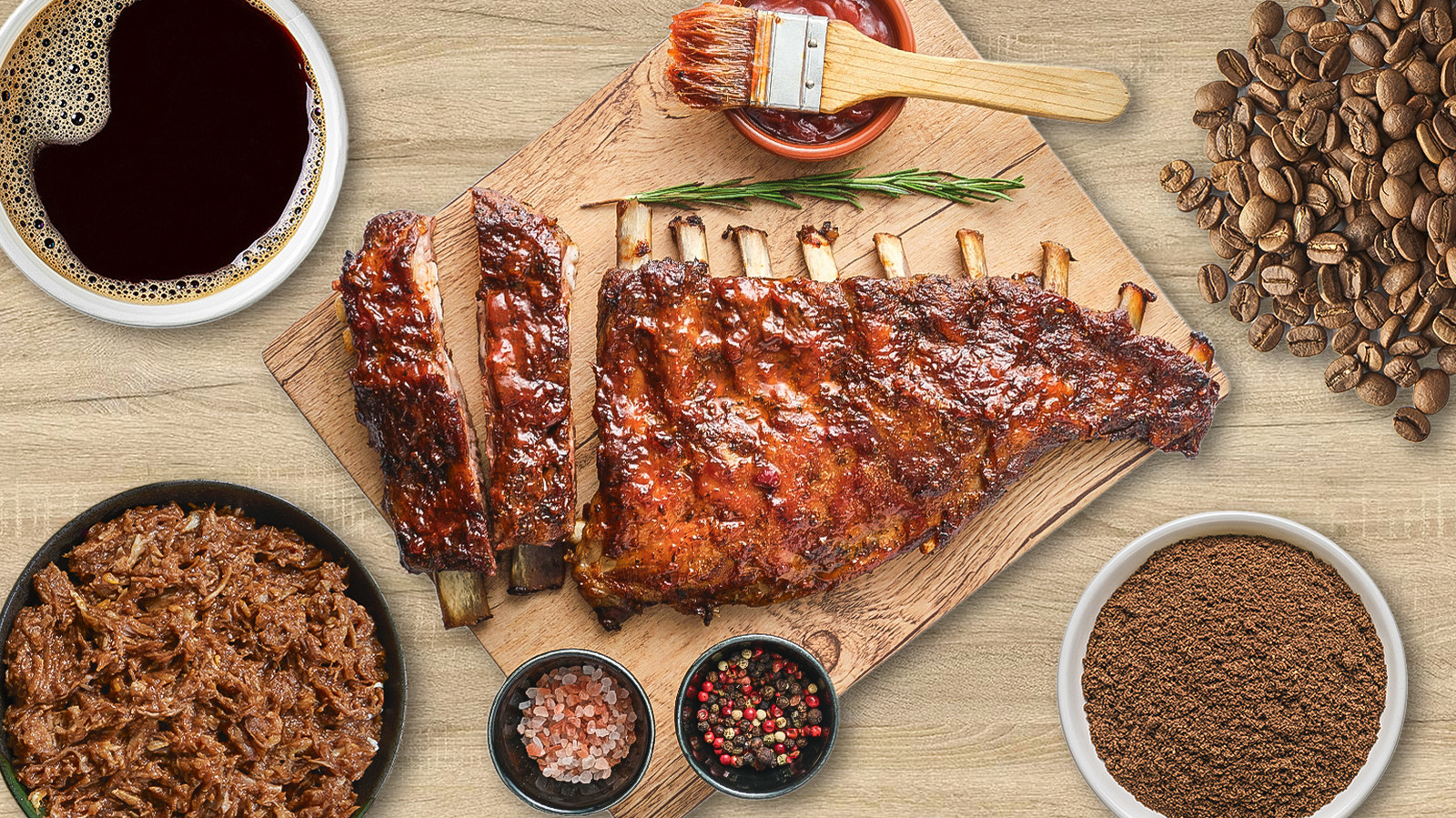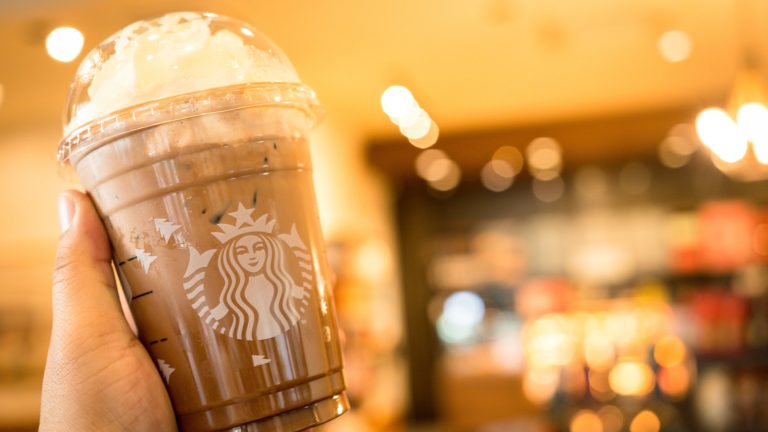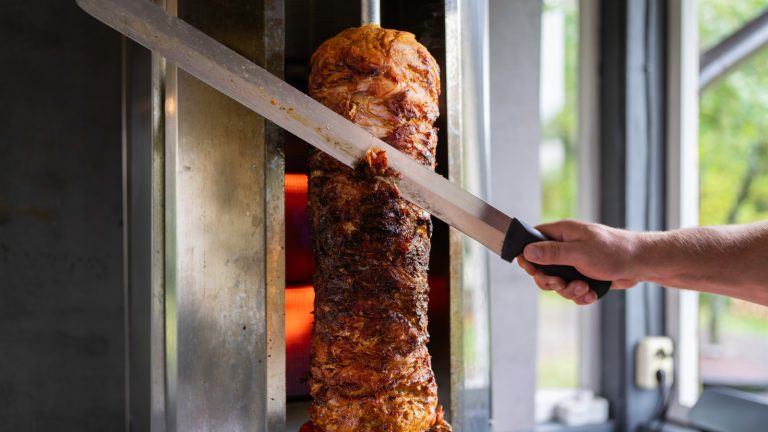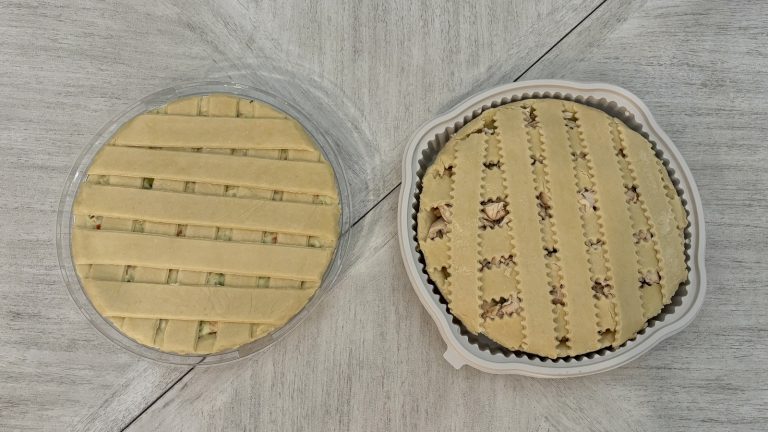We may receive a commission on purchases made from links.
If you’ve never considered adding a little joe to your barbecued meats and other goodies, then you’re missing out. Smoky and fragrant, coffee shares a lot of the same flavor profiles that we love in grilled meat, so the two are an incognito match made in heaven. “Coffee pairs beautifully with barbecue because both share deep, roasted, and bitter notes that amplify each other,” says Thomas Odermatt, CEO of Butcher’s Bone Broth. “The rich, slightly acidic character of coffee cuts through fatty meats, while its bitter edge brings out the smokiness and umami of grilled or smoked proteins.”
It brings a lot of versatility to the table as well. “It goes well in rubs and can add a texture to your bark or skin of the meat,” says Bob Bennett, head chef at Zingerman’s Roadhouse. “It can be acidic, which can help tenderize meat as a marinade. And it can offer a refreshing bitterness to sauces.” Whether you add coffee to barbecue sauce, put it in a rub, brine with it, make a glaze, or doctor up your veggies, it’s a unique and delicious ingredient to make a part of your grilling routine. Here are 15 fun ways to do it.
1. Put ground coffee in a rub
Coffee lends itself well to rub. Bob Bennett typically uses a coffee rub on whole smoked turkeys, while Dennis Littley, the chef and recipe developer behind Ask Chef Dennis, likes to use it on steak or pork tenderloin. “I often make a rub using finely ground coffee, cocoa powder, brown sugar, and a bit of cayenne,” he says. You can also buy a pre-made rub with coffee in it. Options abound, from Spiceology Cowboy Crust Espresso Chile Rub to Sure Shot Sid’s Roasted Coffee Gunpowder Seasoning.
Whether you use your coffee rub on burgers, chicken, or any other kind of meat, though, there are a few mistakes to avoid. For one, make sure you rinse the coffee grounds off before cooking unless you are intentionally trying to create a thick and crunchy crust. “This can create a gritty texture that’s not pleasant to eat,” says Shonali Paul, founder of Paul John Indian Caffeine Company. If you’re going to use actual coffee grounds, as opposed to brew coffee in a marinade or sauce, rinsing is the way to go.
For another, make sure you don’t hesitate to let the coffee flavor come forward. “I think often coffee gets masked in the flavor of the other ingredients,” Bennett says. “If it is good, might as well let it shine.” Rubs, he says, do a good job of letting coffee take the wheel, but make sure you use freshly ground coffee. “I think of it like ground spices. Once it is ground, the flavor lightens exponentially over time,” he explains. “So grinding right before using it is really the best situation.”
2. Make a rich sauce
Humans aren’t strangers to surprising pairings. Chocolate, for instance, has long been embraced in savory applications. “A lot of folks confuse cacao with coffee when it comes to cooking,” Thomas Odermatt says. “Cacao, often used in Latin cuisine — like in mole — brings richness, too, but coffee deserves just as much respect as a cooking ingredient, especially in barbecue.”
He loves to make a coffee-broth infusion, then use that to create a rich, herby Café de Paris-style sauce — a traditional concoction of butter, garlic, lemon, mustard, and fresh herbs, among other flavors — which he pairs with pork tenderloin. Other unique uses for coffee include a savory glaze with beef broth and Worcestershire sauce or a coffee-bourbon sauce with hints of brown sugar and orange.
A sauce, Bob Bennett says, is one of the best ways to bring coffee’s best traits to the forefront of your barbecue dish. “On their own, the grounds have some flavor, but when you add them to fat or a hot liquid, the flavor of the bean really starts to seep out into the sauce,” he says. Just don’t overdo it, Odermatt says. “Coffee is bold, and too much can tip a dish into bitterness or muddiness. The key is balance—coffee should enhance, not dominate. It works best in rubs, glazes, and sauces where it adds depth, smoke, and just enough intrigue to keep guests guessing.”
3. Elevate traditional barbecue sauce
Of course, no discussion of grilled flavors would be complete without a look at traditional barbecue sauce, which is a classic American flavor with a long history. Happily, coffee plays nicely here as well. “A splash in barbecue sauce helps balance the sweetness and adds a nice richness,” says Debra Clark, recipe developer and founder of Bowl Me Over. Just make sure to use it in small amounts, as a little goes a long way.
When you get the amounts right, though, it’s pretty amazing. “As for barbecue sauce, coffee is the secret weapon,” Thomas Odermatt says. “Stir in a bit of brewed light roast, and suddenly your sweet, tangy sauce has a smoky depth that hugs the meat. It’s subtle, but it lingers—and makes people wonder what that magic ingredient is.” You can also use coffee to mellow saccharine sweetness in store-bought barbecue sauce, or use ground coffee to make your own savory sauce from scratch. Try a bit of it in brands such as Sweet Baby Rays Barbecue Sauce Original, 365 by Whole Foods Market Organic Texas True Barbecue Sauce, or Heinz Texas Style Bold & Spicy BBQ Sauce.
If you’re making the sauce yourself, remember to do a headcount so you know how much meat to get for your barbecue, then make enough sauce accordingly. It’s easy to run out for another bottle of sauce, but it’s harder to whip up that from-scratch goodness on the fly.
4. Use coffee with brisket
Brisket is a broadly beloved meat for barbecuing. Because it comes from the cow’s chest, the muscle is typically tougher, making it ideal for the low-and-slow treatment. However, the cut also comes with a deliciously thick and rich layer of fat, flavors that pair well with the smoky acidity of coffee. “For brisket, a coffee rub adds complexity to the bark and helps balance the richness of the fat,” Dennis Littley explains.
Rub is an excellent way to get lots of that coffee flavor onto your brisket. “I like a thick-cut brisket with a nice fat cap, rubbed with a mix of finely ground espresso, salt, pepper, garlic powder, and just a touch of cumin,” Thomas Odermatt says. “The coffee deepens the umami and helps form that rich, caramelized bark everyone’s chasing.” Debra Clark swaps out the cumin in favor of paprika, then adds brown sugar to the mix. “It forms a great crust on brisket,” she agrees.
5. Glaze porchetta
Porchetta is a classic Italian dish, much beloved for the crackling coating on this pork tenderloin cut. The coat of fat, which is typically scored to allow more of the juices out to glaze the meat beneath and ensure an even crackling layer, is incredible when mixed with the subtly smoky flavor of coffee. How do you do the deal, then?
“Toward the end of the roast, I glaze the herb-stuffed pork with a reduction of espresso, balsamic vinegar, and a bit of honey,” Thomas Odermatt says. “It adds a dark, lacquered finish with sweet bitterness that cuts beautifully through the fat — and did I mention that crispy skin?” Of course, that’s not enough coffee for him, so he then pairs it with a ristretto glaze. Ristretto, which is basically a concentrated espresso shot, works well with Bistecca alla Fiorentina as well as porchetta. “It adds depth, elegance, and a little culinary mystery,” he says.
6. Stir coffee into gravy for barbecued meats
Coffee in gravy? Yes, indeed. “Coffee and barbecue might not seem like an obvious pairing, but they actually work really well together,” Debra Clark says. “Coffee brings a kind of rich, roasted flavor that blends right in with the smoky, savory vibe of grilled meats.” Plus, she says, it adds a little bitterness that sits in the background for an extra layer of flavor. She especially likes it with brisket.
You can put gravy in traditional meat gravies, but there are other options as well. “In gravies, coffee can mimic the richness of a red wine reduction, especially good with short ribs or brisket,” Dennis Littley says. Or you can take your cue from Bob Bennett and apply it to your Southern cooking. “We use it in a version of shrimp in grits where we lean into country ham and red eye gravy as the base,” he says. They combine house coffee with Nancy Newsome country ham for a rich, unique flavor profile.
7. Brine your chicken in it
“Brining chicken in with coffee?” Thomas Odermatt asks rhetorically. “Absolutely. I call it Pollo Ristretto. I cool down a brewed light roast, mix it with salt, sugar, bay leaves, and sometimes a whole Calabrian chili, then let the chicken rest overnight. The result is juicy, subtly nutty, and full of personality without overpowering the bird.” Make sure to buy nice ingredients that will have strong flavors. If you can’t get fresh bay leaves and chili pepper, for example, buy highly reviewed online options such as Simply Organic Whole Bay Leaf or Tutto Calabria Crushed Calabrian Chili Pepper.
Dennis Littley likes to make his chicken brine with brewed coffee, salt, orange peel, and peppercorns, which keeps the meat tender and juicy, he says. For her part, Debra Clark likes a combo of coffee, salt, and molasses, which also helps with flavor and tenderness.
8. Crust a steak or ribs
If you want to go beyond a rub and create an actual crust for steak, coffee’s texture is your best friend because one of its most common forms — ground — is already the right texture for blending with ground herbs, spices, and salt. “Think au poivre but with coffee notes,” Bob Bennett says. If you want an extra kick, Debra Clark adds, mix coffee into a chili spice blend and let it sit overnight. “You can also crust a steak with coffee, especially a reverse-seared ribeye,” Thomas Odermatt says. “I use coarsely ground beans with salt and cracked pepper to form a toasted outer layer that plays perfectly with the richness of the meat.”
Make sure if you’re going to make a crust for steak or ribs, though, that you use a recipe. Balancing the flavors is very important, and you don’t want the crust to take over the meat. Plus, once it crusts, you risk losing that delicious, caramelized, smoky outer layer if you simply peel it off. (This is an even more egregious crime if you’re ditching crackling, too.) So, don’t overdo it, and you won’t have to remove it.
9. Marinate or baste meat
The whole point of marinating is to tenderize meat by breaking down tough strands of protein, while simultaneously infusing it with moisture and extra flavor. Being acidic, robust, and savory, coffee does all three. “Brewing a concentrated coffee is a great way to add coffee flavor to meats,” Shonali Paul says. “We have a blend called Smell of Rain that has a bit of chicory in it as well, and if brewed in a South Indian filter, you get a strong concentrate that would be best with sauces or even as a marinade.” (Chicory, which itself has similar flavors to coffee and has been used as a substitute for it, is an ingredient boost you might want to try.)
You can add coffee to a wide variety of marinades, but it’s a good idea to use a recipe so that your cup of joe doesn’t end up overpowering the other flavors. It is an especially nice ingredient in pork shoulder, Debra Clark notes.
If you’re more of a basting type than a marinating one, use coffee. “One of my good friends is a serious pitmaster. Competition-level,” Thomas Odermatt says. This friend swears by using bone broth for basting, which got Odermatt thinking: What about coffee? “So one day I grabbed an old coffee maker (I probably should’ve warned my wife!) and brewed a light roast using beef broth instead of water. She wasn’t thrilled — until she tasted the delicious result.” If you’re basting, though, be safe: Hotec Silicone Heat Resistant Pastry Brushes can help.
10. Mix it into pulled pork
Coffee melds excellently with the rich, fatty, smoky flavor of pulled pork. “When I do pulled pork, a spoonful of brewed coffee in the finishing sauce can lift the flavors just enough without making it taste like coffee,” Dennis Littley says. He notes that it’s important to blend the coffee well with the other flavors involved, and not to simply let it stand on its own. “Coffee needs other components, such as acid, sugar, and heat so it doesn’t taste burnt or bitter.”
Debra Clark agrees that at the end, when you’re mixing the meat, is the time to add coffee to pulled pork. Just a splash will give the meat more depth without calling attention away from its natural porky flavors.
11. Smear it on salmon
Salmon is a popular protein source in the United States, ranking second behind only shrimp as the most commonly consumed seafood. As of 2022, Americans consumed 3.22 pounds per person per year. That’s an average, of course, which means some folks are going much harder and are likely in need of a little reboot. It won’t surprise you to learn that coffee can offer that reboot.
“For salmon, I’ll sometimes make a light coffee-coriander crust before grilling,” Dennis Littley says. “It sounds odd, but it works beautifully.” You can also mix it with flavors such as brown sugar, oregano, cumin, curry, paprika, and cinnamon for a spicy, earthy approach that would be at home on any grill. If you need more variety, never fear: trout, mackerel, and halibut all work, too.
12. Make coffee butter to top meat
If you’re into flavored butters but haven’t yet tried coffee, it’s time to try it. (And if you’re not yet into flavored butters, well, fix that fast, because they are truly delicious.) Coffee butter isn’t hard to make, luckily. “Just mix softened butter with a bit of brewed coffee, brown sugar, and a pinch of cayenne, then melt it over a hot steak,” Debra Clark recommends.
For a different take, Dennis Littley says, blend espresso powder, brown sugar, and butter, omitting any stronger-tasting elements, then put a dollop of the mixture on freshly grilled meats. He too especially likes the richness of coffee butter with steaks. “It’s unexpected but fantastic,” he says. Just make sure you blend it well to meld the textures.
13. Flavor your grilled veggies
Vegetables are delicious on the grill, because they take on the same inimitable, rich flavors from the smoke that meat does. And just like meat, a bit of coffee can do them good. Even better: There are many ways you can accomplish this. “One of my favorites is carrots with a dry coffee rub,” Bob Bennett says. “It plays so well with the sweetness of the carrots.”
While grounds work well with vegetables, brewed coffee does, too. “A drizzle of strong coffee concentrate mixed with balsamic vinegar makes a delicious glaze for grilled vegetables,” Shonali Paul says. “It brings a slightly tangy, smoky note that enhances their natural sweetness.” Meanwhile, Dennis Littley likes his grilled veggies to marinate beforehand in coffee, maple syrup, and vinegar. It works well for carrots, squash, and portobello mushrooms, he says: “The natural sweetness in the veg balances the bitterness from the coffee, and it gives a subtle smokiness.”
Just make sure to tread lightly, cautions Thomas Odermatt. “Vegetables are delicate, and coffee can overpower them quickly.” If you’re worried, you can use that coffee flavor as a finish rather than an ingredient in the initial preparation. “I crush coffee beans with hard herbs like juniper and garlic in a mortar and pestle, then use just a pinch as a finishing dust or light rub,” he says. “It adds a smoky accent without overshadowing the vegetable’s natural sweetness.”
14. Make the best baked beans
If you want to impress everyone at your next barbecue, you can’t forget the side dishes, and there’s no side dish more barbecue-friendly than baked beans. “Here’s a little secret: coffee in BBQ beans is a game changer,” Thomas Odermatt says. “I throw a tea bag filled with ground coffee into a pot of tomato-based beans and let it steep over the fire for 30 to 60 minutes. It adds a rustic, earthy note that pairs perfectly with the sweetness and smoke of the beans.” It is, he says, simultaneously simple, effective, and unforgettable. (If you don’t have a tea infuser, you can choose between Fu Store Stainless Steel Mesh Tea Balls or Disposable Tea Bags for Loose Leaf Tea, both of which have good reviews.)
Just be sure your flavors are balanced, Debra Clark cautions. This isn’t the place to experiment with extra notes. “Skip the flavored stuff,” she advises. “Vanilla or hazelnut roast won’t do you any favors in a rub or sauce.”
15. BBQ your coffee beans
If you’re scratching your head and wondering about barbecuing coffee beans on the grill, you’re not alone. This writer was surprised to learn that you could do such a thing as well, but indeed, it’s not only possible, it can be delicious. “Yes, you can roast green coffee beans right on the grill,” Debra Clark says. “It takes a bit of patience, but the smoky flavor is pretty unique.” It’s that smoky element that really elevates the traditional taste of coffee, so keep the grill closed as much as you can.
Just be sure you keep a close eye on your beans because they can burn in a flash. Keep the temperature low and consistent, and stir frequently to keep them from burning. If you’ve never roasted beans before and want to give it a try, Single Origin Unroasted Green Coffee Beans are a good starting point.





